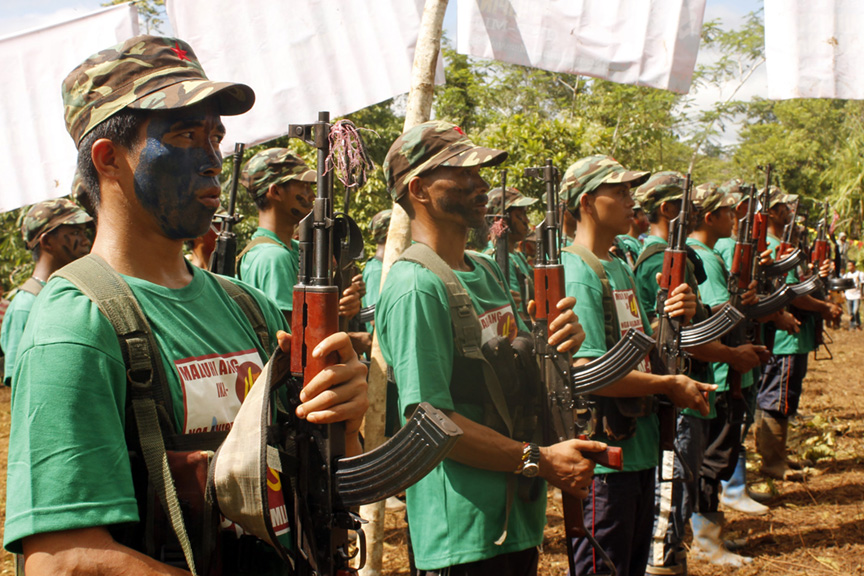
MindaNews file photo
KORONADAL CITY (MindaNews / 17 July) – As intermittent fighting between the government and the communist rebels continues in some parts of the country, the prospects for peace under President Ferdinand Marcos Jr. look “dim,” a US-based non-profit said.
In a report titled “The Communist Insurgency in the Philippines: A ‘Protracted People’s War’ Continues” released on July 13, the Armed Conflict Location & Event Data Project (ACLED) noted that formal peace talks with the communists under the new Marcos Jr. regime are “unlikely to be revived.”
“This would make Marcos Jr. the first Philippine president after the fall of his father’s dictatorship not to seek peace negotiations with the CPP-NPA-NDF,” the ACLED report, written by Tomas Buenaventura, said.
The late dictator Ferdinand Marcos Sr. was ousted by the peaceful EDSA People’s Power revolt in 1986.
ACLED, based in Wisconsin and operating as a non-profit since 2014, has been engaged in disaggregated data collection, analysis and crisis mapping involving conflicts across the globe.
Marcos Jr.’s immediate predecessor, former President Rodrigo Duterte, terminated peace talks between the government and the CPP-NPA-NDF, which stands for the Communist Party of the Philippines-New People’s Army- National Democratic Front, in November 2017.
The Duterte administration proclaimed the CPP-NPA-NDF as a terrorist group but a Manila court dismissed the petition in September 2022.
In December 2018, Duterte established the National Task Force to End Local Communist Armed Conflict (NTF-ELCAC), a whole-of-nation strategy to defeat the communist insurgency.
ACLED noted that Marcos Jr. appeared keen in pursuing the NTF-ELCAC’s favored style of “localized peace talks,” where the government negotiates directly with individuals identified as communist rebels in local areas, rather than with the CPP-NPA-NDF leadership.
The government had described the NTF-ELCAC’s localized peace talks as effective, saying that this approach has convinced rebels to surrender and avail themselves of government assistance, ACLED said.
For its part, the CPP has repeatedly rejected the NTF-ELCAC-backed localized peace talks, asserting that this approach is “a smokescreen for psychological warfare, pacification and suppression operations” and does not address the “long-standing problems of landlessness, oppression and exploitation,” it added.
The last substantial agreement signed between the Philippine government and the communist guerrillas dates back to 1998 and was the first item in the Hague Joint Declaration agenda: the Comprehensive Agreement on Respect for Human Rights and International Humanitarian Law.
The CPP insists that the next step in the peace process should be to negotiate the Comprehensive Agreement on Social and Economic Reforms, followed by the Comprehensive Agreement on Political and Constitutional Reforms, and finally the Comprehensive Agreement for the End of Hostilities and Disposition of Forces.
National Security Adviser Eduardo Año said that Marcos’ marching order is for the NTF-ELCAC to sustain the whole-of-nation approach to peace and development to prevent the communist “terrorists,” their front organizations, and other lawless elements from recruiting, regrouping and regaining power.
“He also directed the task force and the local government units to continue working together to seize the gains in the regions and ensure that we carry this momentum towards total victory over communist terrorism under his administration,” Ano was quoted as saying by the Office of the Presidential Adviser on Peace, Reconciliation and Unity.
NPAs most active in Negros Occidental, Bukidnon
From June 30, 2016 to June 30, 2023, ACLED said that the NPA rebels were most active in Negros Occidental province in Western Visayas and Bukidnon province in Northern Mindanao.
At least 63 clashes between the NPA and the military were recorded during the period.
“This does not come as a surprise for a revolution with an agrarian base. Western Visayas and Northern Mindanao are both known for agrarian unrest, being two of the country’s most important agricultural centers, and therefore serve as ideal staging grounds for the CPP’s revolution,” it said.
Despite the higher levels of fighting between the NPA and state forces in Western Visayas and Northern Mindanao, fighting between both sides was seen in practically all parts of the country from the start of the Duterte regime and into the Marcos Jr. regime, ACLED noted.
This means that the NPA “has been present in every region,” mirroring the prevalence of agrarian issues across the country and widespread poverty of agricultural workers, it added.
But the military and the communists had publicly disagreed on the strength of the NPA.
In its latest anniversary statement in December 2022, the CPP claimed that the NPA had established 110 fronts across the country, while the party itself had set up committees of leadership and branches in more than 70 out of 82 provinces.
The military, meanwhile, claimed that the number of NPA fronts is down to 22 as of December 2022.
Last May, Año said that of these 22 fronts, the number of “active” guerrilla fronts had gone down to two, while 20 have been “weakened.” (Bong S. Sarmiento / MindaNews)
The post Formal peace talks with communist rebels ‘bleak’ under Marcos Jr. – US non-profit appeared first on MindaNews.
0 Comments